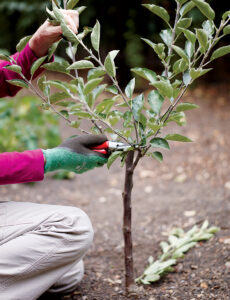Many fruit trees — including semidwarf varieties — can easily grow to 15 feet and taller. Anyone who has tried to manage one of these large trees in a backyard will instantly appreciate the value of small fruit trees: They require less space, are easy to care for, and produce fruit in manageable quantities. Growing compact trees allows you to tuck more varieties of fruit into corners of your property or a small orchard, and means you can choose those varieties by flavor and climate adaptability rather than by tree size. Nearly any standard and semidwarf tree — from pears, peaches and plums to apples and apricots — can be trained to stay much more compact. Learn how to prune fruit trees to keep them small.
The pruning treatment outlined in this article will create an appreciably smaller fruit tree than what you’re used to — as small as most dwarf trees (see Growing Dwarf Fruit Trees). Here’s the key to this little-known technique: Fruit trees’ reaction to pruning is dependent on the season in which the cuts are made. The trees’ response is determined by whether the tree is actively growing (spring), gathering nutrients (early summer), preparing for dormancy (late summer), or fully dormant (fall and winter). Keep this cycle in mind when wielding your shears.

How to Prune Fruit Trees to Keep Them Small: The First Cut
The first step to growing a small fruit tree is to make a hard heading cut (a cut that removes the growing tip) when planting. While such a cut may seem extreme, your planting job will only be complete when you’ve lopped off the top two-thirds of your new tree. This pruning cut is critical because it will create a low scaffold (the primary limbs that make up the canopy of a tree), and making this cut during dormancy will give the tree strength and resilience, which is especially crucial for heavy stone fruits. Most importantly, it will help keep the canopy of the mature tree within arm’s reach.
Here’s how to handle the first cut. As winter comes to an end, and the ground is workable for planting, buy a dormant bareroot tree that’s about as big around as your thumb. Plant the tree as soon as possible. Choose a bud at knee height (about 18 inches from the ground), and make a clean, 45-degree cut that angles away from the bud. Cut close enough to the bud so it can heal cleanly in a natural line, but not so close that you cut into the bud itself. Several buds should remain between the cut and the graft — the knobby place low on the trunk where the scion (the graft that determines fruit variety) meets the rootstock. A knee-high prune is reasonable for almost all fruit trees for small gardens, but peaches and nectarines will sprout more reliably if you cut just above a nurse limb (a branch left to absorb the tree’s spring energy and encourage sprouting). A young tree will probably be a 5- to 6-foot whip at the nursery, so in most cases, you’ll remove more than you’ll leave behind. Your beautiful sapling will now be a knee-high stick.

Granted, this cut sounds harsh. Do it anyway. The compact structure of the tree to come will begin to develop as a consequence. Heading your tree while it’s still dormant will take advantage of nutrients stored in the roots, and vigorous growth and branching will occur in spring, when the plant directs its energy to the remaining buds, the perfect combination of conditions to get a small fruit tree off to a strong start. Your initial cut will awaken the buds below, and they will eventually develop into new limbs, each with a growing tip of its own. The resulting open-center tree will be shorter, stronger, easier to care for, and far more usefully fruitful.
Prune Fruit Trees for Small Gardens: The First Spring
After the first buds start to break in early spring, examine the spacing of the branches and decide if you like the arrangement of the top buds. If not, simply prune lower to a place where the configuration of leafing buds suits you. This place will eventually become the crotch of the tree. The lower the crotch, the easier it will be to keep the tree small. The earlier in the season you make this cut, the more vigorously new limbs will grow.

A young tree with a stem thicker than three-quarters of an inch may have a hard time pushing buds. In this case, make the first dormant cut where the caliper (width of the stem) is thumb-sized, then make a second cut lower as soon as buds begin to develop. After the sprouts get going, you can cut the scaffold as low as you prefer.
Revisit the tree once more in early spring just as sprouts reach 1 or 2 inches long before woody branches begin to form. Gently pinch off all but one bud where multiple sprouts grow on a single node.
Prune Fruit Trees for Small Gardens: The First Summer
In spring and early summer, deciduous fruit trees aggressively expend their energy reserves as they bloom and leaf out. This is when trees are in the mood to grow, and grow they will, often at an alarming rate.
By the time of the solstice in late June, a tree’s resources will have migrated from the roots and trunk to be stored primarily in the foliage. Solstice pruning will remove some of those resources and reduce late season root growth. In other words, summer pruning will slow a tree down, a desirable result for compact fruit trees. While peaches, plums and apricots pruned in fall and winter — the traditional pruning season — can grow as much as 8 feet the following spring, the same pruning cuts made in summer will yield growth of only 1 foot or so. Cuts made while a tree is actively growing will heal quickly, too.

In a perfect world, a young tree would have three or four branches evenly spaced around its trunk. In the real world, branches grow anywhere and anyhow they please. The key to pruning is to envision the future: Consider the placement of the fully grown limbs in relation to one another. You may have too many options. You may have an open area with no branching. You may be tempted to let nature take its course, but leaving too many branches will prevent sunlight from penetrating the interior of the tree. Remove competing branches to create space. An ideal branch angles upward at 45 degrees. If you want to keep a vertical branch, consider a heading cut to encourage horizontal growth, or hang weights on the branch to direct its growth downward.
After removing extraneous branches, cut the remaining scaffold branches back by at least half, to a bud that faces the direction you want the branch to grow. In the case of aggressive growers, such as apricot and plum trees, feel free to prune by two-thirds. Remove any suckers growing from the lowest part of the trunk or the base of the tree.
The closer to the summer solstice you prune fruit trees, the greater your size-control effects. By late summer, nutrients collected by the leaves will have already begun to move into the trunk and roots. A tree begins the shift into dormancy as early as July.

Prune Fruit Trees for Small Gardens: Winter
Winter will be the best time to make structural and aesthetic decisions because your tree will be bare. The dormant season will also be a good time to remove any limbs that just don’t look quite right — those that are too horizontal, grow into a fence, or branch out over a path. You’ll want to remove what Portland, Oregon, pruner John Iott calls “The Three Ds” — the dead, the diseased and the disoriented. Open up the interior with a few well-considered cuts. Observe the growth pattern of the tree, and prune to enhance its natural grace.
Make heading cuts in winter only if you want an enthusiastic response — when you’re trying to develop the first low scaffold branches, or when you’re trying to rejuvenate an older tree. Prune heavily in winter only if a tree has stalled, if pruning has been neglected and needs correction, or if you were too timid last time and want to generate some better choices this time around. The tree will outgrow the pruning with the full force of its reserves.
In subsequent years, just keep pruning: Make architectural decisions in winter and take height down around the summer solstice. When fruit is about the size of the end of your thumb, thin clusters down to a single fruit. Depending on the variety, you may harvest a few fruits by the third year and a few dozen fruits by the fourth.
How should you choose what to keep and what to prune? Ask yourself what seems best, listen to your instincts, and cut something out. The tree will create new choices and you can always make adjustments next season.
Growing Small Fruit Trees: The First Year in 4 Basic Steps
- Prune a dormant, thumb-thick sapling about knee-high, or 18 inches from the ground, when you plant in late winter.
- After buds begin to break the first spring, choose your scaffold. Pinch off all extraneous buds or prune a little lower to a height where the configuration of leafing buds suits you.
- Near the summer solstice, prune to slow growth and begin to shape your scaffold. Remove any redundant branches and make heading cuts.
- In winter, prune to open the interior of the tree and form a well-balanced shape. Remove dead or diseased material.

Why Not Choose a Genetic Dwarf Tree?
Genetic dwarf fruit trees have their short stature bred into their genetic makeup. Genetic dwarfs aren’t grafted; they grow on their own roots. On average, they stay between 6 and 8 feet tall, but are known to be less vigorous and have a shorter lifespan. When a fruit tree is bred for one quality, such as size, then other traits, such as fruit flavor, climate adaptability and overall vitality, become necessarily secondary. By selecting for size, you will miss out on the tastiest varieties.
Some fruit trees are available grafted on ultra-dwarfing rootstocks. These trees stay quite small, a petite 4 to 6 feet, but because of their extremely small root systems, ultra-dwarfing rootstocks present many of the same problems genetic dwarfs do in terms of short lifespan and overall plant health.
Most nurseries offer fruit trees grafted onto semi-dwarfing rootstocks. People seek these out with reasonable expectations of smallish trees, but semidwarf only means “smaller than standard.” If a full-sized fruit tree is 30 feet tall, then a semidwarf might grow to be as tall as 25 feet.
If you want a broad variety of choices, opt for a standard or semidwarf variety. The regular and strategic pruning described in this article is the best way to limit the size of a fruit tree.
For more information, read A Guide to Pruning Fruit Trees

This article was adapted with the permission of Storey Publishing from Grow a Little Fruit Tree by Ann Ralph. Ralph, a fruit tree specialist with 20 years of nursery experience, gives pruning classes in the San Francisco Bay Area.







